
Yesterday’s query-submission packaging in the morning/query content in the evening dichotomy worked so well that I’ve decided to continue it for the rest of this series. Or Tuesday morning, whichever comes first. Hey, posting multiple times a day + doing anything else at all = a certain level of tiredness not conducive to good projective record-keeping. Or retroactive record-keeping, for that matter.
Something the bear in mind on those weekends when you’ve ordered yourself to send out 15 queries before you go to bed on Sunday night, incidentally. Or convinced yourself that if the agent of your dreams asked to see all or part of your manuscript at a conference on Saturday, or in reply to an e-mailed query on Friday, she will be massively offended if the materials aren’t winging their way through the mails or flying toward her e-mail account by noon on Monday. The latter is just not true, for one thing — no agent holds his breath or rearranges his schedule while waiting for requested materials — but regardless of why you’re hurrying, nothing is so conducive to missing important details than a self-imposed deadline.
Yes, you read that correctly: I said self-imposed. Confusing speed of response with meeting a professional expectation is a classic rookie submitter’s mistake. 99% of the time, the unrealistic lapses new writers allow themselves between requests for pages and sending them out neither serve the manuscript’s interests nor have any basis whatsoever in the requesting agent’s actual expectations about when those pages are going to show up.
But that’s not what it feels like when you receive a request for pages, is it? The adrenaline starts pumping: this is my big break!
It isn’t, really — it’s simply the threshold from the first phase of the querying/pitching process to the submission stage. Yet practically every conference-pitcher I’ve ever met has gotten so excited by the first time she was asked by a real, live agent to send real, live pages that she simply dropped everything, printed out her manuscript right away, and popped it into the mail on the next business day. Or had hit the SEND button on an e-mailed submission within hours.
Ditto with receiving a positive response to a query. Often, our heroine chooses to hasten her submission’s arrival even more by paying extra for overnight shipping, under the mistaken impression that it will get her work read faster.
And then she’s horrified to realize three days later that there’s a gigantic typo on page 1. Or that she forgot to include page 58 in the packet, because it wafted out of the printer and behind a nearby chair.
Word to the wise: it’s ALWAYS worth your while to take the time to double-check that everything in your query or submission packet is as it should be. You almost certainly have time to do it: unless an agent specifically asked you to get your materials to him by a specific deadline, or to overnight them, he is not expecting them right away.
Yes, really. And yes, I know that in the first thrill of your writing being treated with respect, it won’t feel that way at all. But trust me on this one: your work will be treated with even more respect if you take the time to make sure that you have presented it professionally.
And what does a professional writer do to assure that? Pull out your hymnals this fine Sunday morning and sing along, campers: by reading every piece of paper that goes in a query or submission packet IN ITS ENTIRETY, IN HARD COPY (yes, even if you are planning to e-mail it; it’s easier to catch typos on a printed page), and preferably OUT LOUD (ditto).
Yes, that’s going to be time-consuming. Your point?
Seriously, would you rather that Millicent judge your writing with that great big typo, or without? With page 58, or without? With the cover letter that was still sitting on your dining room table after you sealed the submission packet, or without?
And so forth. Queriers and submitters often become so focused on getting the darned things out the door that they forget that their success is dependent upon the writing in those packets, not the mere fact of those materials showing up at agencies unscathed. Don’t be so eager to push SEND or tote that box to the post office that you overlook something important.
Like, say, including the synopsis that the agency’s guidelines specified all queriers should include in their query packets. Make a list of what’s required, check it twice — then check it again before you tape up that box.
To help you dot all of the Is and cross all of the Ts, I’m going to devote this morning’s post to giving you the skinny on requests for pages, rather entire manuscripts — what’s known in the biz as a partial. (You’d be surprised at what comes up in a web search of skinny; it was either this or models, interestingly enough. (These fabulous animated bones appear courtesy of Feebleminds, by the way.)
Quite a few aspiring writers seem to find both the logic behind the partial and the logistics behind sending it perplexing. Quoth, for instance, the intrepid reader Kim:
An agent recently requested a partial of ms. and not being able to find much on how to format that I just included the title page, and the requested pages of the ms. Is there a correct format or protocol for partials?
I was delighted that Kim brought this up. Although a partial always refers to a manuscript by definition — the term is shorthand for partial manuscript — this is yet another one of those situations where aspiring writers often get confused by publishing industry terminology.
Yes, I said yet another, because as so often seems to happen in the rumor echo chamber in which those trying to break into the biz must operate, many are the terms that mean more than one thing, or which would mean one thing to an agent and another to, say, a submitting writer. Here we have a prime example of the former: a partial can refer to two different kinds of manuscript, depending upon the context.
So let’s start this discussion by defining our terms before we really give the skeletons something to cavort about, shall we?
The two distinctly different flavors of partial: the first pages
The first kind of partial, the kind to which Kim refers, is a specified number of pages an agent may request a successfully querying or pitching writer who is not yet a client to send. Emphasis on specified: no agent is simply going to tell an aspiring writer, “Send me a partial,” leaving the writer to guess how many pages and from what part of the book.
Instead, she will typically say, “Send me the first chapter/first 50 pages/first three chapters/first 100 pages.” In this context, then, a partial equals precisely the number of pages an agent has requested to see.
Emphasis on precisely: if an agent asks to see the first 50 pages, don’t make the mistake of sending 52, even if page 50 ends in mid-sentence or the chapter ends on the bottom of page 52. Demonstrate that you may be relied upon to do ask you are asked, rather than make up your own rules.
Don’t look at me that way; overstuffed query and submission packets rank among Millicent’s most notorious pet peeves. “But Anne,” those of you glaring daggers in my general direction protest, “that doesn’t make any sense to me. Surely, the agent will be impressed that I paid attention enough to realize that page 50 ended in the middle of a paragraph, and that page 56 provides a natural stopping-point with a real cliffhanger. Or are you suggesting that I should produce a revised manuscript for partial submission in which the cliffhanger is on page 56?”
No — although if you honestly believe there are 6 pages of text in your manuscript that Millicent doesn’t need to see, I would strongly advise doing a bit of revision before you submit, on general principle. It sounds like that text is toting around some extra verbiage. But otherwise, it’s actually a good thing if you’re confident enough in your writing and your understanding of submissions to allow Millie to stop reading in mid-sentence, if that’s what is on the bottom of page 50.
From an agent’s point of view, an ability to follow directions well is a very, very desirable trait in a potential client; clients who second-guess about what’s really meant by straightforward requests are inherently more time-consuming to handle than those who do not.
That’s why, should you have been wondering, the rule of thumb for any submission or query packet is send the agency precisely what it is expecting to see. No more, no less.
Besides, just between us, submitters who round up or round down just to make the writing excerpt complete make Millicent roll her eyes like a teenager in an adult novel. “Wow, this writer is confident,” she mutters, riffling through the ostensible stack of 50 pages that obviously includes at least 10 more. “Confident that I have unlimited amounts of time to spend on a single submission, that is. How big an ego must he have to assume that I would desperately want to keep reading to the end of the chapter after I have already made up my mind whether to request the full manuscript or not? It’s not as though I’m going to remember how these pages left off by the time a requested full arrived. If I were an umbrage-taker, I might even conclude that he thinks I’m too stupid to understand that the book doesn’t end on page 50. I have seen a manuscript before, you know.”
Millicent has a very valid point here: the oh-I-must-send-a-complete-section attitude misses the point of the agency’s having requested a partial in the first place. Basically, this type of partial is a writing sample, similar in function to the pages agents sometimes list in their submission requirements as addenda to the query packet or the brief writing samples agencies sometimes want queriers to include in their query packets: the agent is asking for these pages primarily in order to see whether this aspiring writer can write.
Judging whether the book would be a good fit for the agency comes a close second, of course. However, if Millicent isn’t caught by the style in that partial or writing sample, even a perfect plotline for that agent’s interests is likely to be rejected.
Oh, should I have warned you not to take that great big sip of coffee just before you read that rather disturbing paragraph? Go ahead and clean up; I don’t mind waiting.
I understand your shock at hearing it so bluntly put, oh spit-takers, but ruling out 98% of submissions as quickly as humanly possible is, after all, Millicent’s job. Her boss can only take on a handful of new clients in any given year, right? In order to save the agent time, she makes sure that the only requested materials to reach his desk are well-written, properly formatted, and the kind of story or argument the agent is actively looking to represent.
When an agency requests a partial rather than the entire manuscript, it’s essentially a means of streamlining this winnowing-down process even further. Not to mention saving our Millie from having to shuffle, and thus lift, a ton of paper: instead of her desk being piled up to her chin at any given moment with boxes of full manuscripts, the weekly influx of requested partials may reach only up to her sternum. Once she has screened those, her boss can decide which of the surviving partials have piqued their interest sufficiently to request the entire manuscript.
A process known, both colloquially and within the industry, as asking to see the entire manuscript.
So asking for a partial adds an intervening step between the initial query or pitch and the request for the full manuscript — but before those of you who would prefer your work to be judged in its entirety invest too much energy in glowering in Millicent and her boss’ general direction for sending writers jumping through this additional hoop, let me hasten to add that until fairly recently, most agencies always asked for a partial first; requesting the entire manuscript right off the bat used to be a sign that an agent was really, really excited about a book project and wanted to get the jump on any other agent who might have merely requested a partial.
Nowadays, the decision whether to request a partial or entire manuscript is less often an indicator of enthusiasm than a straightforward matter of agency policy. In fact, contrary to pervasive writerly opinion, being asked for a partial rather than a full can sometimes be an advantage: at some agencies, having the entire manuscript on hand earlier can enable even speedier rejection of a near-miss project.
Think about it: instead of having to ask for pages 51-372 and wait for them to arrive in order to pass a final judgment on a book, Millicent can simply read to page 60. Or page 2.
If the verdict is yes, this can lop quite a bit of time off the agent-seeking process, from the writer’s perspective. Unfortunately, if the verdict is no, and the agency is one of the vast majority that utilize form-letter rejections, the submitter ends up with no idea whether the impetus to reject came on page 1 or page 371.
Renders it rather difficult to guess how to improve the manuscript prior to the next submission, doesn’t it?
Before that rhetorical question depresses anybody too much, let’s return to defining our partials. 99% of the time, the kind of partial an aspiring writer will be asked to provide is this first kind: a requested number of pages, beginning on p. 1 of the manuscript, for submission to an agent. There is, however, another variety.
The two distinctly different flavors of partial: the taste of what is to come
After an author is already established, it is not unheard-of for her agent to be able to pull off a conjuring trick known as selling the next book on a partial. This is pretty much what it says on the box: the author produces the first X number of pages of a not-yet-completed novel, and the agent convinces an editor that it will be to the publishing house’s advantage to snap the book up before the author has polished it off.
This can be a very good deal for the publisher: buying a book on a partial prevents other publishers from bidding on the finished work. Also, earlier involvement in the writing process often enables the editor to help shape the book more, in much the same way as an editor on a nonfiction book (typically sold on a book proposal, not the full manuscript, lest we forget) is able to dictate which of the proposed chapters will and will not be in the finished manuscript.
Not to mention the fact that if the book happens to be written by a famous author or celebrity in another field, the bidding could potentially get quite high. This is why one occasionally hears of a publisher’s acquiring a half-written novel at a cocktail party, because some celebrity simply handed ten pages to him along with his seventh martini: the publisher recognizes the potential marketing value of the name.
For your garden-variety serious novelist, however, such a situation is unlikely to arise. If her agent manages to sell her next book on a partial, it’s generally to the editor who acquired her last. Since so many first-book publishing contracts grant the publisher right of first refusal over the author’s next book, anyway — meaning that the publisher gets an exclusive peek at the book before anyone else can place a bid on it — selling on a partial is mostly a means to speed up the approval process.
Everyone clear on the difference between that kind of partial and the first kind? Excellent.
Now let’s assume that, like Kim, you have just been asked to submit a partial to the agent of your dreams. Let’s further assume that your manuscript (or whatever portion of it an agent or editor has requested that you send to be perused by Millicent, the Platonic agency screener) is already in tip-top formatting shape, all typos and logic problems removed, and thus what the industry calls clean — and if you’re not absolutely positive that your pages meet ALL of those conditions, stop right here and make a plan for tidying up your pages toute suite.
Trust me, this is a situation where spelling counts. As does grammar, punctuation, and everything else your 9th grade English teacher begged you to take seriously.
But once your work is in apple-pie order, as Louisa May Alcott used to say so frequently, what next?
What should a partial submission packet include, and in what order?
In part, this is a trick question, because — chant it with me now, campers — any submission packet should include precisely what the agent asked you to include, no more, no less. In the words of the immortal Fats Waller, find out what they like and how they like it, and let ‘em have it just that way.
Okay, so he wasn’t talking about literature when he sang that. Roll with me here.
As I mentioned above, agents are usually quite specific about what they want in a submission, up to and including the number of pages they want to see. If you doubt this, check out an agency’s website or one of the standard agency guides, then attend a conference where agents are scheduled to speak. Raise your hand and ask whether it’s okay to send, say, the 55 pages it would take to round out a chapter when an agent has asked to see the first 50.
You will be astonished at how people who say their preferences in clients are as vague as writers who produce “good writing in any genre” will suddenly transform into rule-hugging lovers of draconian efficiency, appalled at the very notion of extending the length of the partial. Or, indeed, at the notion of the writer being the one to decide what should and should not be in the submission packet.
To save you the trouble of asking, let me tell you what they will say: never, ever, EVER send what you THINK they want to see instead of what they have actually ASKED to see. Of course, you may offer in your cover letter to send more, but that is all.
So — and this should sound a teensy bit familiar by now — if you’ve been asked for the first 100, and the chapter ends in a blow-your-socks-off cliffhanger on p. 101, you should still only send the first 100, exclusive of the title page. (Since the title page is not numbered, it is not included in the page count, by the way.)
Of course, as we discussed above, if you wanted to be Machiavellian about it, you could always perform a little strategic snipping prior to that, so said cliffhanger topples just on the bottom of p. 50. No one would fault you for that, for the very simple reason that it’s extremely unlikely that Millicent will ever sit down with your partial and full manuscript simultaneously. Remember, if an agency approves enough of a partial submission to want to see the rest of the novel, they’re going to ask for the entire manuscript, not, say, pages 51 through 373.
Oh, you thought Millicent was going to invest time in digging out your partial, unpacking your second submission, and fitting the two together like a jigsaw puzzle? Does that really sound like reasonable behavior to expect from the person too impatient to allow her latte to cool before taking her first sip?
At the risk of repeating myself: send precisely what you are asked to send.
However — and this should sound familiar on the secret handshake front — any agent is going to assume that a writer of your caliber is already aware that certain requests imply certain inclusions. Here are the extra bits, in the order in which they are generally expected to appear in a packet containing a partial:
1. Cover letter
An astonishingly high percentage of submissions arrive without a cover letter, and often without a title page as well, begging the question: what makes these writers so positive that the requesting agent will still remember their queries or pitches well enough to render page one of Chapter 1 instantly recognizable the nanosecond Millicent pulls it from the packet?
I hate to burst anyone’s bubble, but it’s not going to be — in fact, in many agencies, the person who heard the pitch or read the query won’t even be the first person to screen the submission. There may even be several Millicents who need to approve it before it gets anywhere near the agent of your dreams. So it doesn’t honestly make sense to assume that everyone who sets eyes on your manuscript will already be familiar with your work.
Besides, including a cover letter is polite — and more or less necessary, if you have been asked to submit your pages as attachments to an e-mail, right? Just remember: NEVER e-mail pages unless specifically asked to do so, or unless that preference is explicitly expressed in the agency’s submission guidelines. (And if you do e-mail requested materials, send them as Word attachments, saved as .doc files; other word-processing programs, Text Edit files, and/or PDFs are not currently acceptable at US agencies. So if you have been writing in another program, do bear in mind that you will need to switch to industry-standard Word before an agent can submit your work to a publishing house.)
The cover letter needn’t be a long-winded missive, or even chatty: a simple thank-you to the agent for having asked to see the materials enclosed will do. Something, perhaps, along the lines of this little gem:
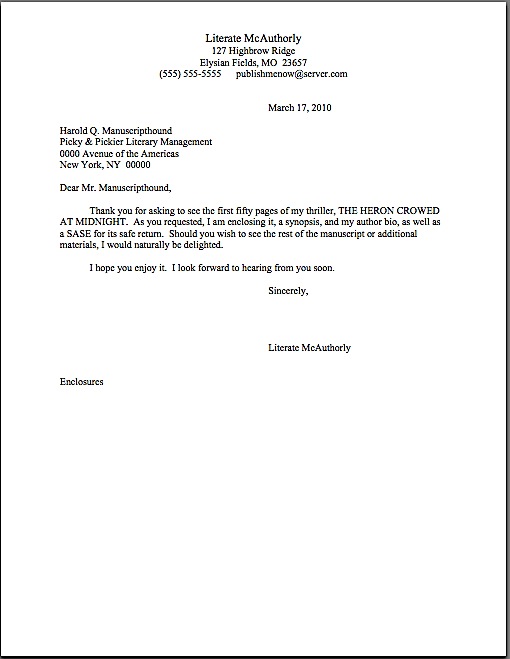
A miracle of professional blandness, is it not? That’s fine — the cover letter isn’t where you’re going to wow Millicent with your sparkling prose and trenchant insight, anyway. All you have to be here is courteous.
If you met the agent at a conference, mention that in the first paragraph of the letter, to help place your submission in context. As crushing as it may be to the aforementioned writerly ego to contemplate, an agent who spent days on end listening to hundreds of pitches probably is not going to remember each one. No need to re-pitch, but a gentle reminder never hurts.
If another agent is already reading all or part of the manuscript you’re sending — or has asked to see it — be sure mention this in your cover letter. No need to say who it is or how long s/he has had it; just tell the recipient that s/he’s not the only one considering this project. Unless the agency has a policy forbidding simultaneous submissions, withholding this information will only generate resentment down the line if more than one agent wants to represent your book.
Yes, even if that agent to whom you submitted 9 months ago has just never responded. Actually, it’s in your strategic interest to contact that non-responder to let her know that another agent is interested; it often speeds up the evaluation process. (If you’re unclear on why, please see the WHAT IF MORE THAN ONE AGENT ASKS TO SEE MY MANUSCRIPT? category on the archive list at right.)
Most importantly, make sure all of your contact information is on the letter, either in the header (letterhead-style, as in the example above) or just under your signature, and do be absolutely certain that the letter includes the title of your book, just in case the letter and the manuscript end up on different desks.
Yes, it does happen — and if it does to yours, do you seriously expect Millicent to have to dig back through her recycling bin or deleted e-mails for your original query in order to dig up your contact information. No, you understand the overwhelming influx of queries and submissions too well for that. Fortunately, you have the option to include another safety net, one that’s more likely to stay with your pages.
2. Title page
Since a professionally-formatted title page contains the writer’s (or, after you’ve landed an agent, the representing agency’s) contact information, this is where Millicent will look first for yours. So you should always include a title page in a submission packet, if any manuscript pages have been requested — yes, even if you have already sent the first 50 pages, and are now sending the rest of the book.
No need to state on the title page that it’s a partial, either. Millicent will be able to figure that out from your cover letter and the thickness of the stack of paper. Just use the same title page that you would have used if the agent of your dreams had requested the entire manuscript, and you’ll be fine:

Not precisely a thrill-fest, but undoubtedly professional-looking. Just make sure that it’s in the same typeface as the rest of the attached manuscript. (If this all sounds completely cryptic to you, or if you have never formatted a professional manuscript before, don’t panic — you’ll find a step-by-step explanation of what to do under the HOW TO FORMAT A TITLE PAGE category at right.)
There’s another excellent reason to include a title page. Long-time readers, chant it with me now: because the submission looks more professional that way. Speaking of which…
3. The requested pages in standard format.
Again: only the pages they’ve asked to see, beginning on page 1, professionally formatted. No substitutions, unless the agency website specifically asks for something else.
You absolutely must check the agency’s submission guidelines — usually available on its website or in its listing in one of the standard agency guides — before you submit, because as we have already discussed, not every agency wants to see precisely the same thing. The vocal minority of agents who now prefer only one space after periods and colons (not the new universal norm, no matter what you’ve heard), for instance, tend to feel strongly enough on the subject that you might even want to do a quick web search under the requesting agent’s name, to rule out the possibility that s/he has expressed this opinion on a blog or in an interview lately. (And yes, if s/he blogs, the Millicents who work at that agency will expect you to be familiar with those expressed preferences. Again, time-consuming, but ultimately worth it.
Does that anguished wailing mean that somebody out there has a follow-up question? “But Anne,” those of you who were under the impression that the one- vs. two-space debate had already been settled in some mythical convention of agents and editors that never in fact took place, “I’ve already changed my manuscript from two post-period spaces to one, because I heard somewhere that was what everyone expects now. Isn’t that true? And do you mean anything else by the ominous-sounding term standard format?”
Why, yes, oh wailers, I do — and the existence of actually industry-wide standard format expectations is the main reason I draw such a strong distinction between them and even rather commonly-held individual agents’ preferences. (You’ll find a complete list, in-depth analysis, and visual examples of the former in the aptly-named HOW TO FORMAT A MANUSCRIPT and STANDARD FORMAT ILLUSTRATED categories on the list at right.) To continue with our example already in progress: standard format still calls for two spaces after a period or colon, because it’s much, much easier to edit a manuscript in that format. However, a hefty percentage of agents (particularly younger ones or those who work primarily with genre fiction) have come out of late in favor of manuscripts that echo the new paper-saving publishing practice of leaving only one.
In fact, many of them express it as a pet peeve. So when you are submitting pages to these specific agents, it would not be very wise to include that literacy-requisite second space, would it?
But it would be almost as foolish to submit a manuscript with only one space after a period or colon to an agent who did not adhere to this preference. (I say almost, because advocates of tradition tend to be less doctrinaire on the subject — and, frankly, there are plenty of agents out there who just don’t care.) If an agent already knows that the editor to whom she planned to take a manuscript will take offense at the newfangled disregard of standards that have been in place for about 150 years, the argument but I heard somewhere that it had changed! just isn’t going to fly.
I repeat (and shall continue to repeat): there is no substitute for doing your homework about what the specific agent you are approaching expects to see, either on the page or in a packet.
For the benefit of those of you who are going to blow off that last piece of advice because you’re in a hurry — oh, I know that you’re out there — allow me to add something you would have learned from those posts on formatting, had you been paying attention: a manuscript intended for submission should not be bound in any way. No staples, no paper clips, and certainly no spiral binding.
Oh, and do use at least 20-lb, bright white paper when you print it out. Cheaper paper can begin to wilt after the first screener has riffled through it. Yes, it does increase the already quite substantial cost of submission, but this is one instance where being penny-wise can cost you serious presentation points.
“So basically what you’re saying, in your patented lengthy and meticulously-explained manner,” those of you who have been paying close attention point out, and rightly, “is that Kim did everything right. Aren’t you?”
Why, yes, I am — kudos for your submitting savvy, Kim! You’re an example to aspiring writers everywhere, all the more so, in my opinion, because you were brave enough to ask the question. Now, everyone who has been wondering about it can benefit.
Sometimes, though, agents ask to see additional materials slipped into a submission packet with a partial. Tomorrow morning, we’ll be taking a swift barefoot run through the usual suspects, as well as revisiting the difference between a partial and a writing sample — or a partial for a contest entry and a writing sample, for that matter.
Hard to contain the excitement, isn’t it? No wonder the skeleton is dancing up a storm. See you back here this evening around 8 pm PST (a writer’s coming over to talk plot, so I’m not sure I’ll be back at my computer in time for a 7:00 post) for more talk of query content, everybody, and keep up the good work!









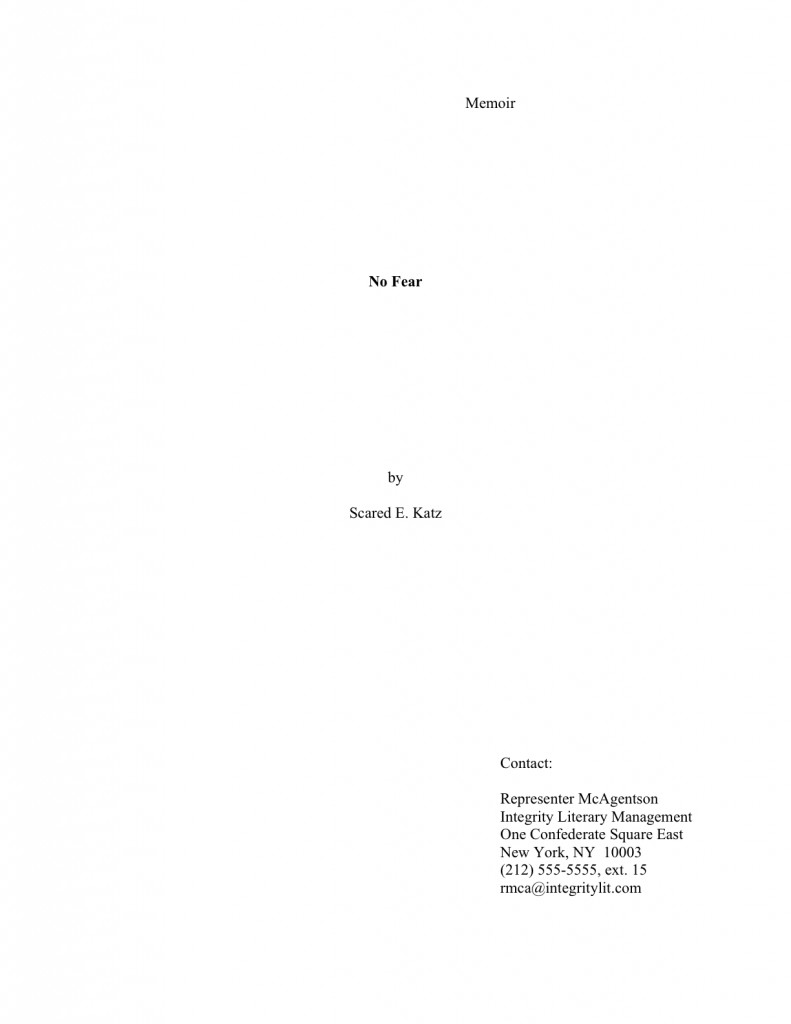
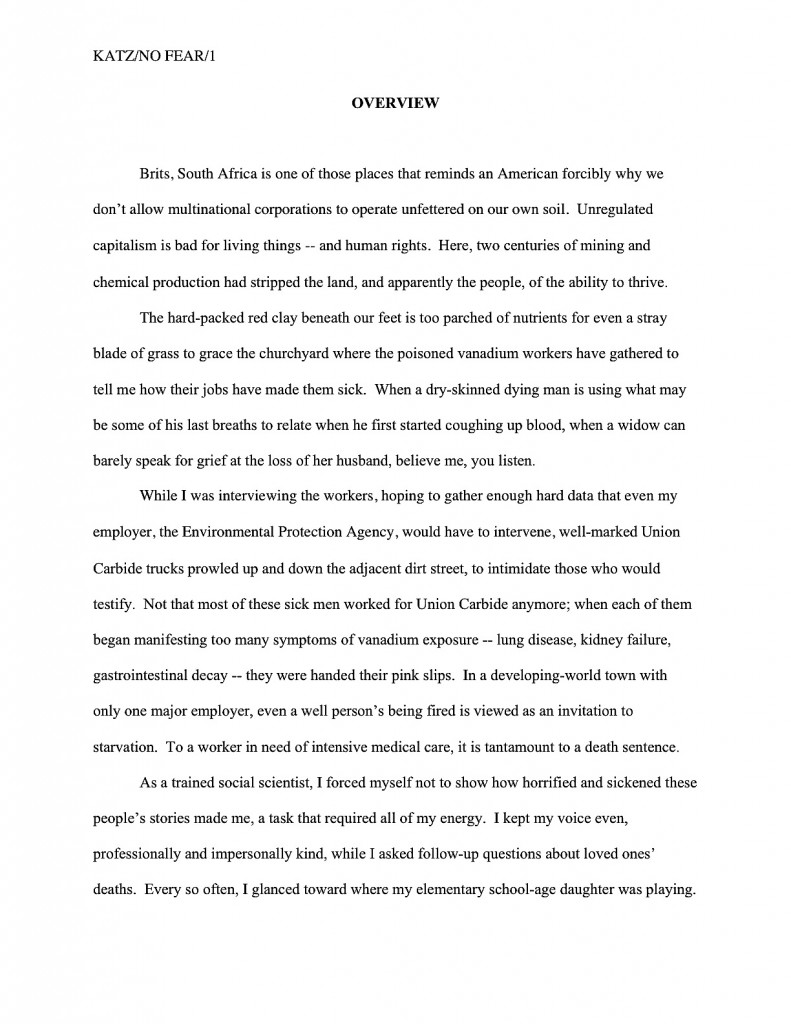
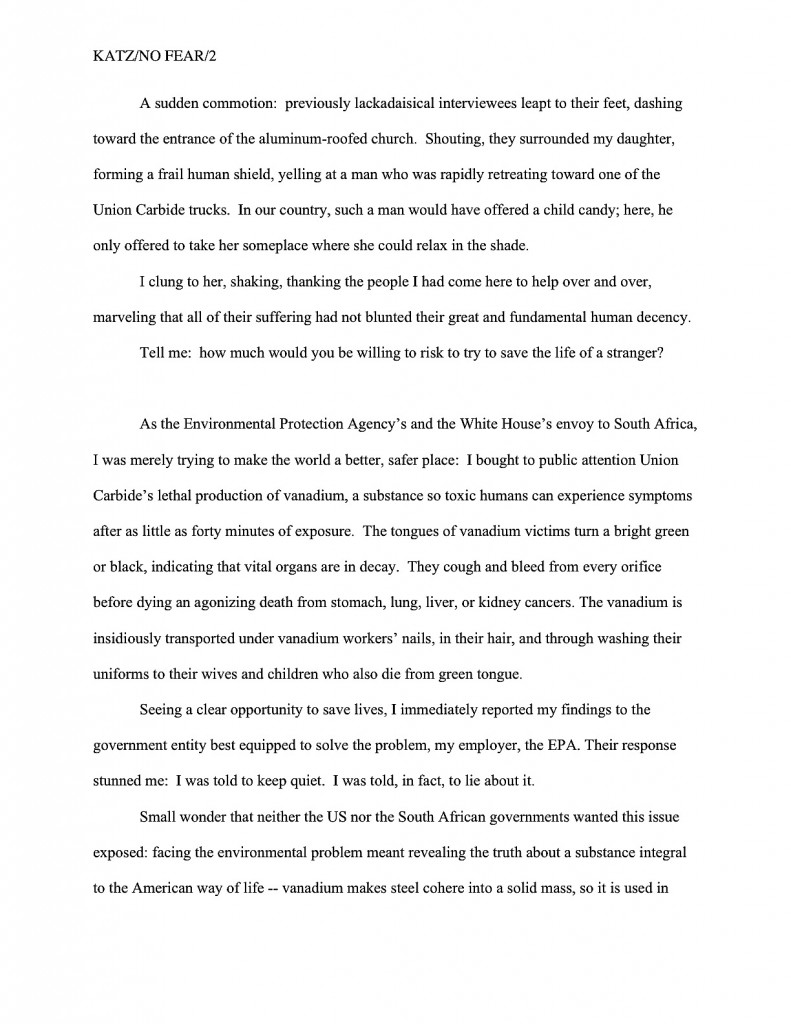
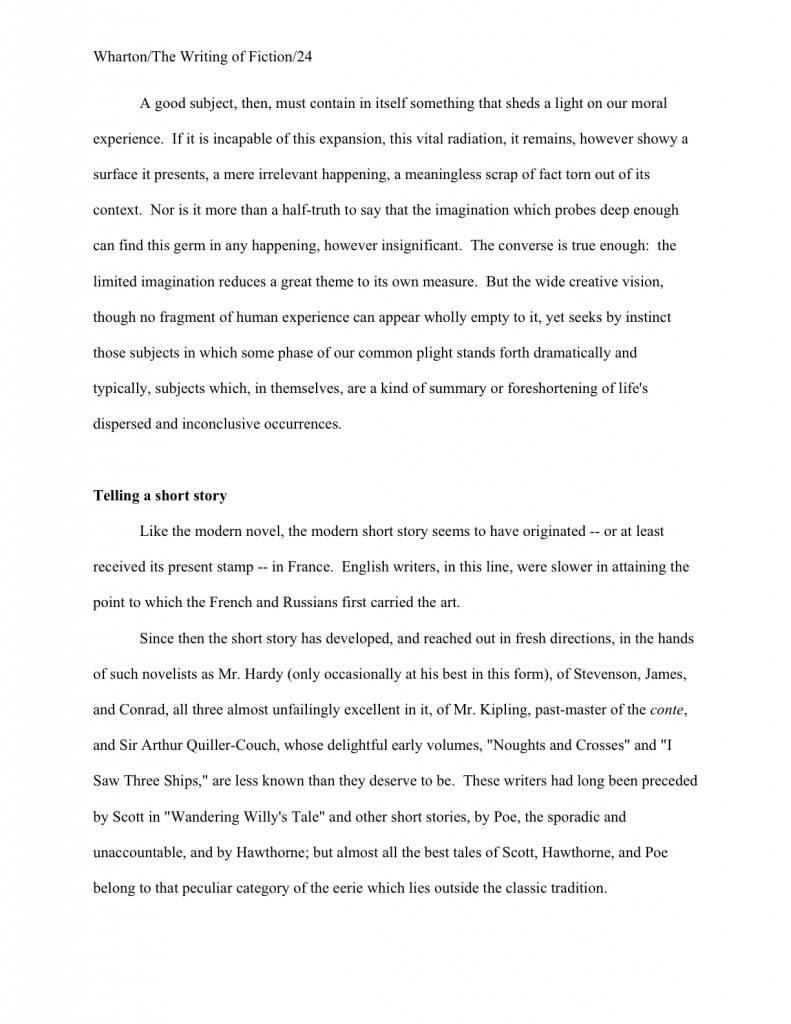
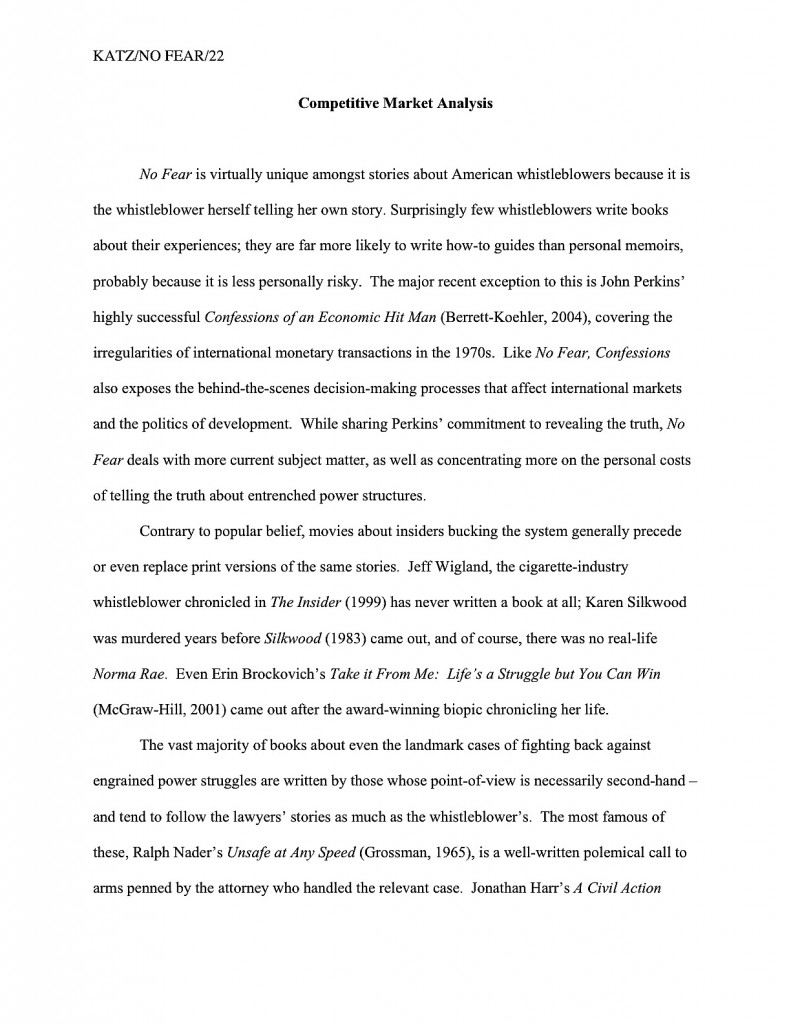


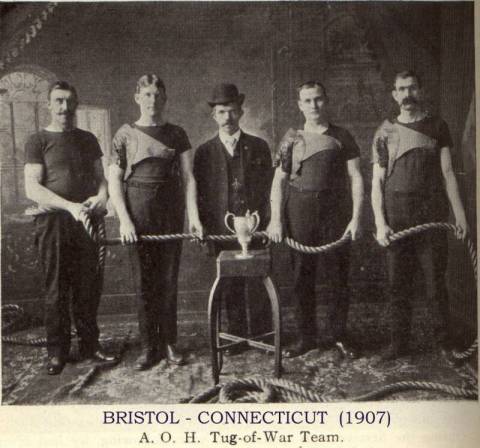





 Those of you who were hanging around the Author! Author! virtual lounge may remember Stan from last year, when he was kind enough to visit with
Those of you who were hanging around the Author! Author! virtual lounge may remember Stan from last year, when he was kind enough to visit with  How can a man die twice?
How can a man die twice?
 Michael Stanley is the writing team of Michael Sears and Stanley Trollip.
Michael Stanley is the writing team of Michael Sears and Stanley Trollip. 
 PS: yes, I know that this series has been long and dense, but I have a fabulous reward in store for you at the end of it: a guest post from an author I’ve been eager to get here to talk to you for a very long time. Hint: he’s funny, and appropriately for the season, there will be small, fluffy animals involved.
PS: yes, I know that this series has been long and dense, but I have a fabulous reward in store for you at the end of it: a guest post from an author I’ve been eager to get here to talk to you for a very long time. Hint: he’s funny, and appropriately for the season, there will be small, fluffy animals involved.
